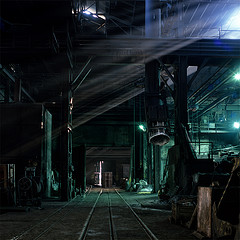Discussion of Swords in Japanese History
 The oldest swords on record in Japan were sent to a queen from China in roughly 250a.d. At this period a great number of the swords came from China made of Iron. Along about the 5th century is when steel swords were finally created.
The oldest swords on record in Japan were sent to a queen from China in roughly 250a.d. At this period a great number of the swords came from China made of Iron. Along about the 5th century is when steel swords were finally created.
The technology to create steel from Iron involves carbon material during the smelting process. It is this additional material that creates an iron alloy or – steel. This alloy then allows the metal to be harder (addition of carbon), but not so hard that it becomes brittle, and will therefore still maintain its' malleability from the Iron. The hardness is required to hold an edge during the sharpening process, while the iron softness allows the blade to withstand metal to metal contact during battle situations without shattering the blade as would happen with extremely rigid metal.
In the beginning Japanese swords were straight. A straight blade was very common and practical for the foot soldier. Once the calvary was introduced and fighting on horseback became an effective way to wage a war between about 800 – 1200ad, curved swords became common and the sword of practical choice. These initial long curved swords were called Tachi. Future swords were given different names and these names were given primarily due to the length of curvature of the sword. Nevertheless, Japanese swords have always typically been made with a single sharpened edge, however in the beginning of the sword making process, their did exist double–edged swords.
After 1200ad the Minomoto clan had defeated the enemy clan and came into power. It was about this time that the Samurai class came to prominence. The capitol setup by the ruling clan became a magnet for swordsmiths from all over the country, and swords making came into a greater prominence.
In 1274 and 1281 the Mongol invasions caused the future modifications of the swords being built due to the tips breaking. This kind of damage was not reparable and therefore caused changes in the way swords were made.
Then in 1334 a battle between the North and the South began between emperors Godaiko and Komyo. This struggle for power continued for several a centuries. During this time however, the need for swords increased and as often happens the sword making became a manufacturing process rather than a quality process and so the sword quality suffered. It was also during this time that the foot soldier was the primary source of military power, which caused the need for shorter swords which became the Katana. These shorter swords were easier to maneuver in hand–to–hand combat and were more in line with the combat tactics of the time.
In the mid 1500s the gun was introduced by the Portuguese and thereby changed the face of warfare forever. Obu Nabunaga used these new weapons in a decisive battle that utterly destroyed a clan known for their skill and bravery. Although these new guns were not as accurate, they were certainly effective. The battle field now belonged to groups of men armed with guns. Accordingly, the armor changed to accomadate this new weapon and became heavy to protect from the bullets. Swords were still used at that time and so these too also needed to be modified. The swords in this era became longer and heavier to slash through the thick armor.
The long centuries of war came to an end. The country was now unified under the authority of Toyotomi Hideyoshi who adopted a feudal system. Since a relative peace had been established, the Samurai class found themselves in a state of proverbial limbo – there was no war to fight. And so the Samurai warrior schools were setup to teach new recruits the ways of the Samurai and maintain the ability to fight. There were many schools at this time.
In 1868, emperor Meji took control and the period of modernization began up until the present day. This new system denied the rights of the Samurai among the most notable were the priviledge of wearing the daisho – the two sword combination typically worn to distinguish the Samurai class. During these times, the ability and knowledge to make Samurai swords was nearly lost, but recovered in the early 50's. Today the art of making Japanese swords is exactly that, an art. People all over the world want to collect and display these works of art because they convey so much; beauty, grace, style, discipline, and a connection to a past that was our own, once upon a time.





Рейтинг популярности - на эти заметки чаще ссылаются:
- 43 Герой социалистического труда
- 42 Известный телеведущий целую неделю снимал о Южном Урале
- 41 Первый чугун на каменном угле
- 39 Механизация очистки горновых канав
- 38 Замена конвейерных лент
- 36 Отработка верхнего шлака
- 34 Безотходное производство чугуна
- 33 Металлургия России: всем выйти из кризиса Читать полностью:
- 33 Ремонты чугунных и шлаковых канав
- 33 Системы программного управления